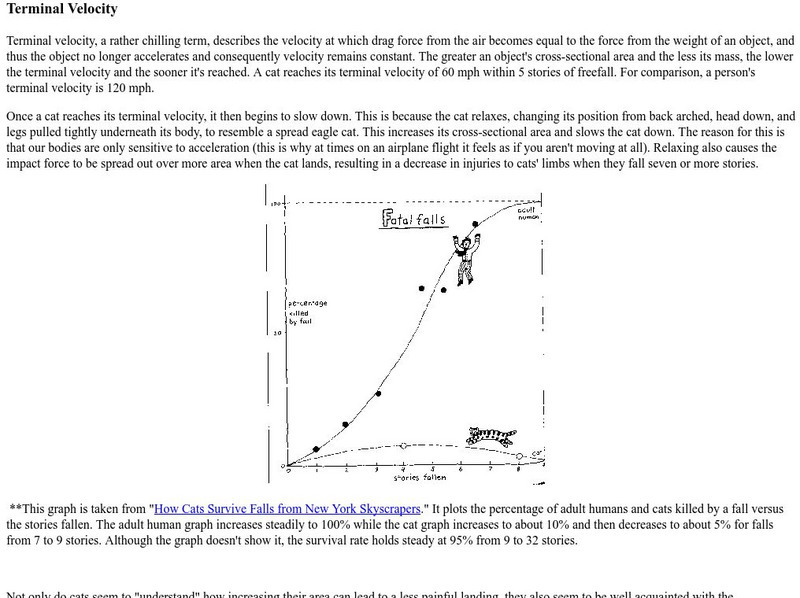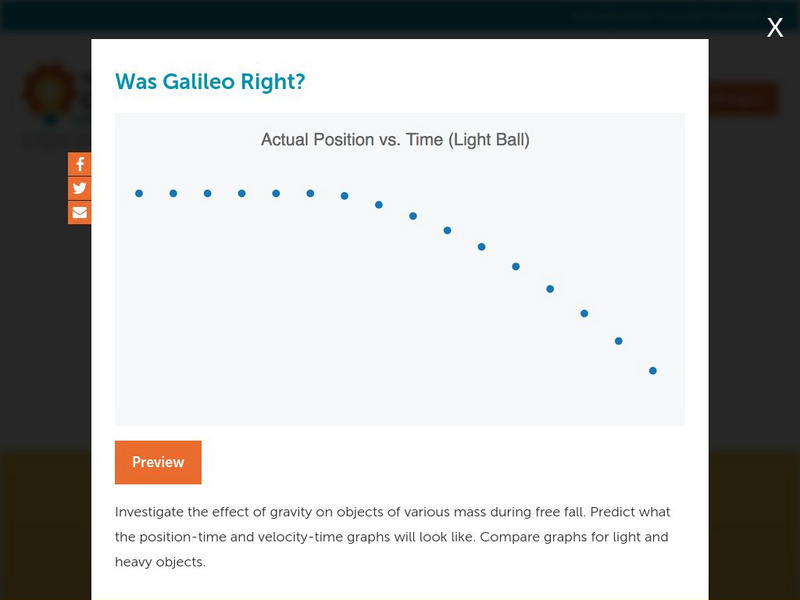Texas Instruments
Texas Instruments: Free Fall
This activity assesses students' knowledge and understanding of free fall principles.
Texas Instruments
Texas Instruments: Picket Fence Free Fall
In this activity, students will measure the acceleration of a freely falling body (g) to better than 0.5% precision with the help of a Picket Fence and a Photogate.
Texas Instruments
Texas Instruments: Falling Down
In this activity, students will determine the average speed of a falling object. They will observe whether or not changing the mass and keeping the same shape have an effect on the average speed of the object.
Texas Instruments
Texas Instruments: Falling Objects
In this activity, Students can use a Motion Detector to measure distance and velocity.
Physics Classroom
The Physics Classroom: 1 D Kinematics: Table of Contents
Learners examine motion with words, equations, diagrams, and graphs. Some topics investigated are position, velocity, acceleration, and free fall. The tutorial consists of lessons and problems to check for understanding.
TED Talks
Ted: Ted Ed: Free Falling in Outer Space
With a little help from Sir Isaac Newton, Matt J. Carlson explains the basic forces acting on an astronaut during a free fall. [2:59]
Other
University of Alaska: Terminal Velocity
University of Alaska physics professor site explaining the concept of terminal velocity. Uses the terminal velocities of humans and cats for comparison. Site contains an interesting graph of the percent fatalities versus stories fallen.
Varsity Tutors
Varsity Tutors: Web English Teacher: William Golding
Web English Teacher site provides a variety of resources to assist in the teaching of William Golding's works.
CK-12 Foundation
Ck 12: Physical Science: Acceleration Due to Gravity
[Free Registration/Login may be required to access all resource tools.] Acceleration due to gravity and why falling objects with different masses accelerate at the same rate.
Nobel Media AB
The Nobel Prize: The Nobel Prize in Literature 1983
This site from the Nobel eMuseum allows you to read about William Golding (1911-1993 CE), the author honored for his novels and a recipient of the 1983 Nobel Prize in literature. This website is organized into the following sections:...
TeachEngineering
Teach Engineering: How Do Things Fall?
Students learn more about forces by examining the force of gravitational attraction. They observe how objects fall and measure the force of gravitational attraction upon objects.
Georgia State University
Georgia State University: Hyper Physics: Energy of Falling Object
This site is from the Physics Department at Georgia State University. The reliance upon the law of conservation of energy as an approach to problem-solving is presented and encouraged. It is modeled through a problem involving a...
Physics Classroom
The Physics Classroom: 1 D Kinematics: Acceleration of Gravity
The practice problems and illustrated examples in this tutorial help students understand the acceleration of gravity. The 'Value of g' widget the tutorial refers to can be found in the Interactives section (link is in side-bar) under...
Physics Classroom
The Physics Classroom: 1 D Kinematics: Representing Free Fall by Graphs
In this physics tutorial, the motion of a free-falling motion will be represented using position versus time and velocity versus time graphs.
Physics Classroom
The Physics Classroom: 1 D Kinematics: The Big Misconception
An introduction to the ideas behind the misconception and misunderstanding of why all objects accelerate at the same rate. This explanation involves the concepts of force and mass.
Physics Aviary
Physics Aviary: Drone Delivery Lab
This lab is designed to have students find the relationships that govern the behavior of a package that has been released by a drone that is flying horizontally. Students will have control over the drone's height and horizontal speed....
Physics Aviary
Physics Aviary: Pvc Freefall
This lab was designed to give students practice collecting and analyzing data for the PVC Freefall Lab. Masses are dropped from different heights and the speed of the object as it passes through a photogate is calculated. The...
Physics Classroom
The Physics Classroom: 1 D Kinematics: How Fast? And How Far?
Students understand the physics of a free falling object through these illustrated example problems.
Concord Consortium
Concord Consortium: Was Galileo Right?
Investigate the effect of gravity on objects of various mass during free fall. Predict what the position-time and velocity-time graphs will look like. Compare graphs for light and heavy objects.
NASA
Nasa: Beginner's Guide to Aerodynamics
Includes exhaustive information and a wealth of activities pertaining to aerodynamics and the physics of flight.
Physics Classroom
The Physics Classroom: Elephant & Feather (Free Fall)
A demonstration involving an elephant and a feather and explanation of why all objects maintain the same acceleration in the state of free fall without any air resistance.
Khan Academy
Khan Academy: Freefall Review
Review the key concepts and skills for acceleration due to gravity, including analyzing motion of objects in freefall.
Physics World
Physics World: Contextual Physics in Ocean Park
After downloading the "Motion Video Analysis" software, users can collect data about moving object's position from digital movie clips. This collection of data will allow them to plot motion graphs and draw conclusions about physics in...
NASA
Nasa: Beginner's Guide to Aerodynamics
This site from NASA uses a colorful graphic to illustrate why objects reach terminal velocity. Provides equation for the terminal velocity of an object. Graphic is accompanied by a simple explanation.

















